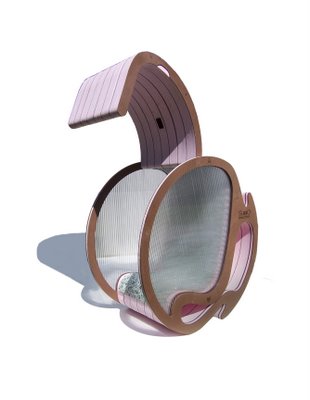skip to main |
skip to sidebar
In reconsidering the assignment I've decided to construct a layering map. This map will condition how the earth as a whole reacts and exists through a terrestrial impact event. When an impact occurs many large scale processes take place including the displacement of atmoshpere, land, water (megatsunami's), the occurance of global firestorms, acid rain, temperature abnormalities, seismic shaking, ejecta deposition, air blasts, and thermal radiation.
This is a lot of information. For this mapping I have selected thermal radiation, ejecta deposition, and air blasts to use as information for layering ontop of a topographic mesh model of the earth (seen below). To gather data I have located a program created by scientists at the University of Arizona. This is a web-based program that calculates the effects of an earth impact. The program can be located here. Using this program I will relate my chosen processes in terms of distance from a given location on the earth. Essentially mapping how the effects of a terrestrial impact diminish as distance from the point of origin is increased.


this is the first step of the animation. next will be to animate a metorite colliding with the earth and deforming its surface.
earth animation
 On the surface, Earth doesn’t look nearly as abused as Mercury or the Moon. However, the earth has been struck by more than 10 times the amount of impacting objects. Over time this has produced approximately 3 million impact craters from 1 km in diameter to more than 1000 km in diameter. You would never see evidence of these impacts by simply studying the Earth’s surface due to geologic processes such tectonic plate subduction, mountain building, erosion, and volcanism. Mountain building crumples impact craters, plate subduction consumes them, erosion d
On the surface, Earth doesn’t look nearly as abused as Mercury or the Moon. However, the earth has been struck by more than 10 times the amount of impacting objects. Over time this has produced approximately 3 million impact craters from 1 km in diameter to more than 1000 km in diameter. You would never see evidence of these impacts by simply studying the Earth’s surface due to geologic processes such tectonic plate subduction, mountain building, erosion, and volcanism. Mountain building crumples impact craters, plate subduction consumes them, erosion d issects them, and lava flows and sediments often bury them. These events essentially mask the effect of impact craters on our planet. As a result, only about 160 surviving impact craters have been found and documented so far. The most famous of these 160 impact craters is the 180 km diameter Chicxulub impact crater on the Yucatan Peninsula of Mexico. Studies of this crater and the mass extinction event that occurred on Earth 65 million years ago have shown that impact cratering can affect both the biologic and geologic evolution of a planet. A much better record of what the Earth might look like without its surface changing events can be seen on the Moon because there is no water on its surface, lava no longer erupts from its volcanoes, and plate tectonics have never occurred there. There are over 300,000 impact craters about 1km in diameter on the Moon. Parallels can be drawn between the Earth and the Moon because the craters on the Moon have been created as asteroids and comets hit its surface, and at the same time similar objects hit the Earth. From the Moon’s impact history we can conclude that due Earth's larger size, it would have suffered about 10 times more impact events, or over 3 million impact craters greater than 1 km in diameter.
issects them, and lava flows and sediments often bury them. These events essentially mask the effect of impact craters on our planet. As a result, only about 160 surviving impact craters have been found and documented so far. The most famous of these 160 impact craters is the 180 km diameter Chicxulub impact crater on the Yucatan Peninsula of Mexico. Studies of this crater and the mass extinction event that occurred on Earth 65 million years ago have shown that impact cratering can affect both the biologic and geologic evolution of a planet. A much better record of what the Earth might look like without its surface changing events can be seen on the Moon because there is no water on its surface, lava no longer erupts from its volcanoes, and plate tectonics have never occurred there. There are over 300,000 impact craters about 1km in diameter on the Moon. Parallels can be drawn between the Earth and the Moon because the craters on the Moon have been created as asteroids and comets hit its surface, and at the same time similar objects hit the Earth. From the Moon’s impact history we can conclude that due Earth's larger size, it would have suffered about 10 times more impact events, or over 3 million impact craters greater than 1 km in diameter.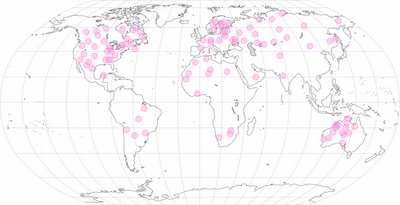

The Specialized Unit for Mega-communicative Occupancy, or SUMO, is a unit that provides a comfortable and soundproof environment for one person to effectively communicate with the outside world with the use of a laptop computer. Designed and fabricated digitally, the form allows for easy mobility and visibilty of internalized operations.
 The design initiated from the research of five teams. After discussing the case-studies on structure, acoustics, ergodynamics, audio/video, and graphics, the teams began to form ideas and devise solutions that would meet all requirements.
The design initiated from the research of five teams. After discussing the case-studies on structure, acoustics, ergodynamics, audio/video, and graphics, the teams began to form ideas and devise solutions that would meet all requirements.
 The final form originated from these two earlier study models: one based on a circular shape to allow for ease of mobility with a door latch and multiple interior forms and the second based on an S-curve which followed the body and utilized the stacking of a series of ribs. In the combination of these two ideas, the final design included the S-curve shape on the interior and conformed to a near circular exterior shape for easy relocation. The door was designed to open and provide a working space for occupants. Each rib is made of 3/16" masonite and contains 5 sheets of 1/4" foam insulation sandwiched in between. Foam serves a lightweight material that also provides greater strength. There are several sets of masonite and foam together, not including the outside rib on each side.
The final form originated from these two earlier study models: one based on a circular shape to allow for ease of mobility with a door latch and multiple interior forms and the second based on an S-curve which followed the body and utilized the stacking of a series of ribs. In the combination of these two ideas, the final design included the S-curve shape on the interior and conformed to a near circular exterior shape for easy relocation. The door was designed to open and provide a working space for occupants. Each rib is made of 3/16" masonite and contains 5 sheets of 1/4" foam insulation sandwiched in between. Foam serves a lightweight material that also provides greater strength. There are several sets of masonite and foam together, not including the outside rib on each side.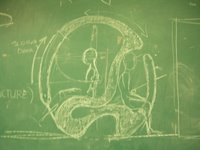

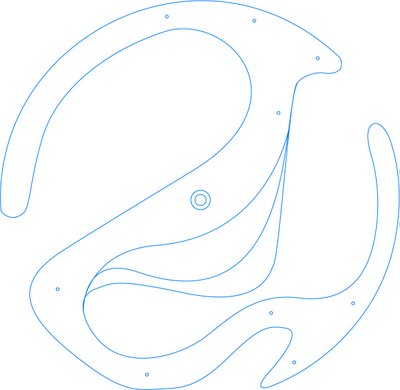


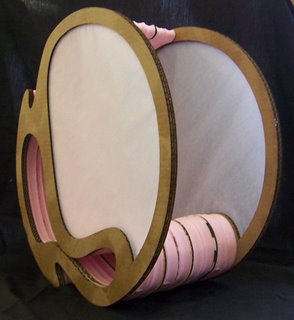









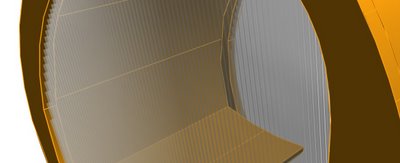 The final prototype was constructed using the CNC router and laser cutter technology. In addition to the foam and masonite rib construction, polycarbonate hollow panels were used for the side panels for greater acoustic quality. A highly detailed lock, created using the laser cutter technology alone, secures the door in place. As a final touch, branding included two sumo wrestler figures and a rastered description of the design. The overall budget of the project was $820, including all materials.
The final prototype was constructed using the CNC router and laser cutter technology. In addition to the foam and masonite rib construction, polycarbonate hollow panels were used for the side panels for greater acoustic quality. A highly detailed lock, created using the laser cutter technology alone, secures the door in place. As a final touch, branding included two sumo wrestler figures and a rastered description of the design. The overall budget of the project was $820, including all materials.













 The SUMO has potential to span great distances. With the idea of distance learning and its coupling with the internet, the pod introduces many possibilities. With the construction being fairly simple, this prototype can be mass-produced in large numbers and distributed to universities around the world, making each of them communication hubs. Students have the opportunity, even in some of the most noisiest conditions, to seclude themselves and converse via webcam in SUMO.
The SUMO has potential to span great distances. With the idea of distance learning and its coupling with the internet, the pod introduces many possibilities. With the construction being fairly simple, this prototype can be mass-produced in large numbers and distributed to universities around the world, making each of them communication hubs. Students have the opportunity, even in some of the most noisiest conditions, to seclude themselves and converse via webcam in SUMO.
- studioMEGA






